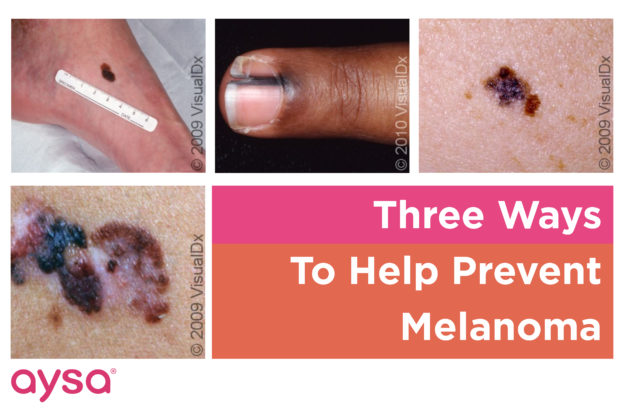In honor of Skin Cancer Awareness Month, we wanted to take this opportunity to provide helpful information on how to prevent melanoma. Skin cancer is the most common of all cancers.1 Although melanoma is the least common of skin cancers, it causes the most skin cancer deaths by far. The good news is that if it is recognized early, it can be successfully treated.
Here are three ways you can help prevent melanoma:
Know Your Risk Factors
It is estimated that in 2019, 7,230 people are expected to die of melanoma.1 Though the disease can affect anyone, increased risk factors2 include:
- A family history of melanoma – If someone in your family had melanoma, it increases your risk 10-fold.
- Fair skin, light eyes, and a tendency to freckle – The risk of getting melanoma is 1 in 50 for Caucasians, 1 in 200 for Hispanics, and 1 in 1,000 for people of African descent.
- A large number of moles, especially unusual appearing moles.
- History of frequent sun exposure, especially in childhood.
- History of sunburns.
- Decreased immune system, such as transplant patients and patients with HIV/AIDS.
Check Yourself
Though melanoma is the deadliest skin cancer, it is highly treatable when caught early.3 The best way to protect yourself is to perform self-exams. The warning signs are known as the ABCDEs of melanoma.2
- A – Asymmetry: One-half of the mole does not look like the other half.
- B – Border: The outline of the mole is irregular.
- C – Color: More than one color can be seen, such as brown, black, red, blue, and white.
- D – Diameter: A mole larger than 6 mm (1/4 inch), which is roughly the size of a pencil eraser.
- E – Evolving: Changes in the mole over time.
Self-exams should be performed once a month in a well-lit area after a shower or bath. Using a mirror can be helpful for difficult-to-see areas of the skin.
Contact your doctor if you identify a suspicious mole or other skin mark!
Avoid Sun Exposure & Don’t Forget Your Sunscreen
UV sun exposure is another huge risk factor for developing melanoma. In fact, nearly 90% of melanomas are thought to be caused by UV light and sunlight.4 Sunburn also plays a huge role in increasing the chances for the disease. One blistering sunburn can more than double a person’s chance of developing melanoma later in life. Be sure to have proper SPF coverage when you are in the sun, and avoid tanning beds at all costs.
When it comes to a suspicious mole or other skin mark, it is always recommended to contact your dermatologist or primary care physician as soon as possible.
Everyone will likely face a skin issue in their lifetime. With the snap of a picture, Aysa is here to answer all your questions and give guidance on what to do next. Download our app today!
References:
- American Cancer Society. Key statistics for melanoma skin cancer. https://www.cancer.org/cancer/melanoma-skin-cancer/about/key-statistics.html. Accessed May 10, 2019.
- Melanoma. https://www.skinsight.com/skin-conditions/adult/melanoma. Accessed May 10, 2019.
- American Academy of Dermatology Association. Melanoma. https://www.aad.org/public/diseases/skin-cancer/melanoma#overview. Accessed May 10, 2019.
- Melanoma Research Foundation. Melanoma facts & stats. https://melanoma.org/melanoma-education/understand-melanoma/facts-stats/. Accessed May 10, 2019.

